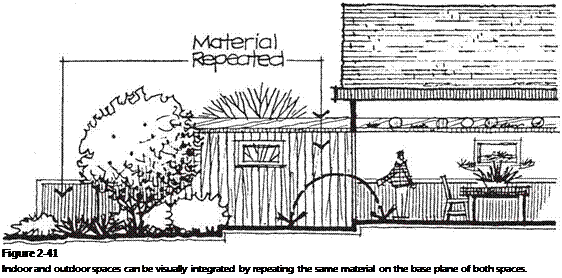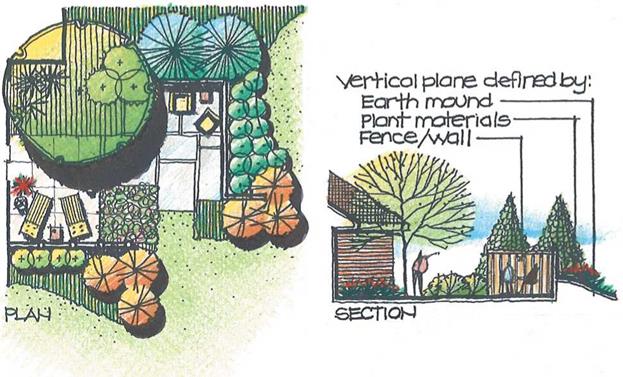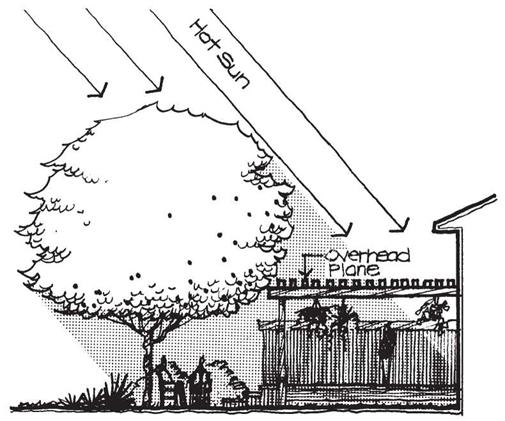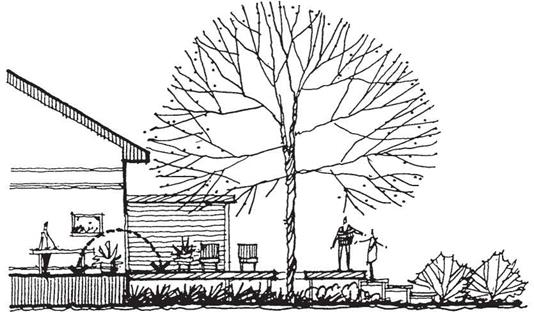The outdoor living and entertaining space has a number of functions, like those of its indoor counterpart. It should be designed to accommodate individual and small – group relaxation, conversation, and interaction in relative peace and quiet, yet be flexible enough to hold larger groups of people for parties and other social gatherings.
One of the first considerations for designing the outdoor living and entertaining space is to establish the correct proportions and size so that it will function properly. This space (and its subspaces) should have fairly equal plan proportions to support its use as a gathering and meeting space (Figure 2—33). Long, narrow proportions should be avoided because they imply movement, like a hallway, and it is difficult to arrange furniture for conversation. The size of the space should be determined based on the anticipated number of people who will be using the space along with the required furniture. Information on the suggested sizes of typical spaces and elements is presented in Chapter 8. To prevent the outdoor living and entertaining space from becoming too large in scale, it can be organized as a series of smaller subspaces, each accommodating a particular function (sitting, entertaining, sunbathing, reading, and so on). This can be accomplished by varied plan configurations, differences in pavement material, and elevation changes (Figure 2—34).
The designer should also study the arrangement of furniture and other elements in the outdoor living and entertaining space so conversation, circulation, and other activities can take place appropriately. A designer should never just create a space or become overly enamored with its shape without an idea of how the space will actually function. Too many times, a space is designed with little or no idea in mind as to where people will actually sit, what they will look at, or where they will walk through the space. Chairs, for example, should be arranged in a generally circular group so people can face each other to talk. Circulation routes also need to be anticipated so they won’t cut directly through a conversation group in a disruptive manner (Figure 2-35).
Another important consideration is for the designer to establish a sense of enclosure in the outdoor entertaining space, particularly with the vertical and overhead planes. Enclosure by the vertical planes can be created with walls, fences, steep slopes

of the ground, or plant materials either individually or in combination with each other. Vertical planes can also screen views of the neighbors and create privacy as well as block cold wind or hot late-afternoon sun (Figure 2—36).
The overhead plane can be defined with trellises, arbors, pergolas, canvas awnings, tree canopies, and so on (Figure 2—37). As in the outdoor entry foyer, the overhead plane can establish a “ceiling” and make the space seem more comfortable and intimate in scale. It is often more desirable to sit beneath an overhead plane with a partial or complete sense of cover than in a wide-open space with a totally open feeling. The overhead plane doesn’t have to cover the entire space. It may extend over only a portion of the outside living and entertaining space rather than over the entire area (Figure 2—38). This creates subspaces, some shaded and some sunny. The overhead plane can also cast dramatic shadow patterns on the ground plane and provide places to hang such things as potted plants and wind chimes.
|
Figure 2-36 Vertical planes can be used to provide spatial enclosure and privacy in outdoor living and entertaining spaces. |
|
Figure 2-37 Overhead planes in the living and entertaining space can be defined by natural and artificial elements. |

Although the outdoor entertaining space should have a sense of enclosure, especially for privacy, it should not feel totally walled in. There should be adequate openings in both the vertical and overhead planes of the space to allow for some views and sunlight. At strategic points along the vertical plane, views can be directed toward special accent areas situated on or off the site. In fact, there should be a conscious effort to establish focal points at various places throughout the site to capture views (Figure 2—39). In some instances, it may be desirable to take advantage of views off the site to a golf course, lake, or distant mountain range. However, views should not be allowed to drift off the site in an unplanned manner.
The ground plane in the outdoor entertaining space should also be given considerable attention. It should be constructed with a stable and durable material that reinforces the intended character of the space. The residents and their guests are apt to spend many hours in this space, allowing them to notice the detail and craftsmanship of materials more closely than in other areas. Therefore, the texture, color, patterns, and construction detail of the materials should be visually attractive and coordinated. Potential materials and patterns are discussed more thoroughly in Chapter 12.
Where appropriate, an attempt should be made to visually and functionally coordinate the outdoor entertaining space with the adjoining interior room(s) of the house. It is usually desirable to integrate the indoors and outdoors so they are perceived as a coordinated series of usable spaces linked together in the same overall environment. Again, the designer can work with all three planes of spatial enclosure to accomplish this. On the ground plane, one way to coordinate the indoors with the outdoors is by extending the indoor floor elevation to the outdoors by means of a wood deck (Figure 2—40). Indoor and outdoor spaces can also be visually integrated by repeating the same materials or patterns on the ground or walls. A ceiling can be extended to the outdoor living and entertaining space by means of an overhead arbor or awning (Figure 2-41).
In conclusion, the outside living and entertaining space is potentially one of the most intensely used spaces on the residential site. If designed properly, it will be the center of outdoor activity for the family’s use as well as formal and informal entertaining of
|
Figure 2-39 A variety of accents can be used to create views throughout the backyard. |
|
Figure 2-40 Indoor and outdoor spaces can be visually integrated by making the base plane the same elevation in both spaces. |
 |
guests. For this to occur, the space should be comfortable to use throughout the day and evening, with characteristics similar to those of the indoor living and entertaining room.
Kitchen
The kitchen is normally a utilitarian room of the house. Its primary purpose is to prepare, cook, eat, and store food. But the kitchen can be a place for socializing, too. Have you ever noticed how many parties you have been to where people tend to congregate in and around the kitchen? But it is important to note that all the appliances are efficiently located around a central area for ease of working. A good kitchen typically has ample counter area for work space and for storing cooking utensils. It is normally located where there is easy access to and from outdoors for transporting groceries and taking out the garbage. The kitchen is often adjacent to the breakfast area and/or dining room, so food can be conveniently transported back and forth.







